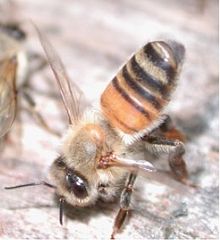
Summary
The Nasonov (alternatively, Nasanov) pheromone is released by worker bees to orient returning forager bees back to the colony. To broadcast this scent, bees raise their abdomens, which contain the Nasonov glands, and fan their wings vigorously.

Nasonov includes a number of different terpenoids including geraniol, nerolic acid, citral and geranic acid.[1] Bees use these to find the entrance to their colony or hive, and they release them on flowers so other bees know which flowers have nectar. Once the foraging bee leaves the nest it uses its sense from special sensing cells on the antennae to locate and distinguish forage plants, which each give off a unique blend of odour chemicals. When a beekeeper lifts out frames from a hive they disturb the balance of smells within the hive. It can take up to 48 hours for the colony to re-establish its scent equilibrium.
A synthetically produced Nasonov pheromone can be used to attract a honey bee swarm to an unoccupied hive or a swarm-catching box. Synthetically produced Nasonov consists of citral and geraniol in a 2:1 ratio.
The Nasonov gland was first described in 1882 by the Russian zoologist Nikolai Viktorovich Nasonov.[2][3][4][5] Nasonov thought that the gland performed perspiration;[6] it was Frederick William Lambert Sladen (May 30, 1876 - 1921) of England who in 1901 first proposed that the gland produced a pheromone.[7]
See also edit
References edit
- ^ Williams, Ingrid H.; Pickett, J. A.; Martin, A. P. (March 1981). "The Nasonov pheromone of the honeybee Apis mellifera L. (Hymenoptera, Apidae). Part II. Bioassay of the components using foragers". Journal of Chemical Ecology. 7 (2): 225–237. doi:10.1007/BF00995745. PMID 24420468. S2CID 39709618.
- ^ Насонов, Н. В. [Nasonov, N.V.] (1885) "О строеніи кожныхъ железъ пчелъ" [On the structure of the skin glands of bees] Известия Императорского Общества Любителей Естествознания, Антропологии и Этнографии: Зоологический Сад и Акклиматизация, Том второй. Годичное Заседание Отделения Беспозвоночных Животных Императорскаго Русскаго Общества Акклиматизации Животных и Растений 27 Июля 1882. [News of the Imperial Society of Lovers of Natural Science, Anthropology and Ethnography: Zoological Garden and Acclimatization, volume two. Annual Meeting of the Department of Invertebrate Animals of the Imperial Russian Society for Acclimatization of Animals and Plants July 27, 1882.] 46:2-3. (in Russian)
- ^ naturebee (February 13, 2016). "The biography of Nikolai Viktorovich Nasonov". Beesource. Retrieved 30 May 2021.
- ^ Nasonov's findings were reported to the West in 1883 by A. Zoubareff (also spelled: Zoubarev):
- Zoubareff, A. (November 1883). "A propos d'un organ de l'abeille non encore d'ecrit" [Regarding an organ of bees that has not yet been described]. Bulletin d'Apiculture pour la Suisse Romande (in French). 5 (11): 215–216.
- Republished in English: Zoubareff, A.; Benton, Frank, trans. (15 December 1883). "Concerning an organ of the bee not yet described". The British Bee Journal. 11: 296–297.
{{cite journal}}: CS1 maint: multiple names: authors list (link)
- ^ Snodgrass, Robert E. (1925). Anatomy and Physiology of the Honeybee. New York City, New York, USA: McGraw-Hill. pp. 114-117 (and references on pp. 307-313).
- ^ (Snodgrass, 1925), p. 114.
- ^ See:
- (Snodgrass, 1925), p. 116.
- Sladen, F. W. L. (11 April 1901). "A scent organ in the bee". The British Bee Journal. 29: 142–143, 151–153.
- Republished in condensed form in: Sladen, F.W.L. (1 August 1901). "A scent-producing organ in the abdomen of the bee". Gleanings in Bee Culture. 19: 339–340.
- Reprinted in: Sladen, F.W.L. (September 1902). "A scent-producing organ in the abdomen of the worker of Apis mellifera". The Entomologist's Monthly Magazine. 38: 208–211.


